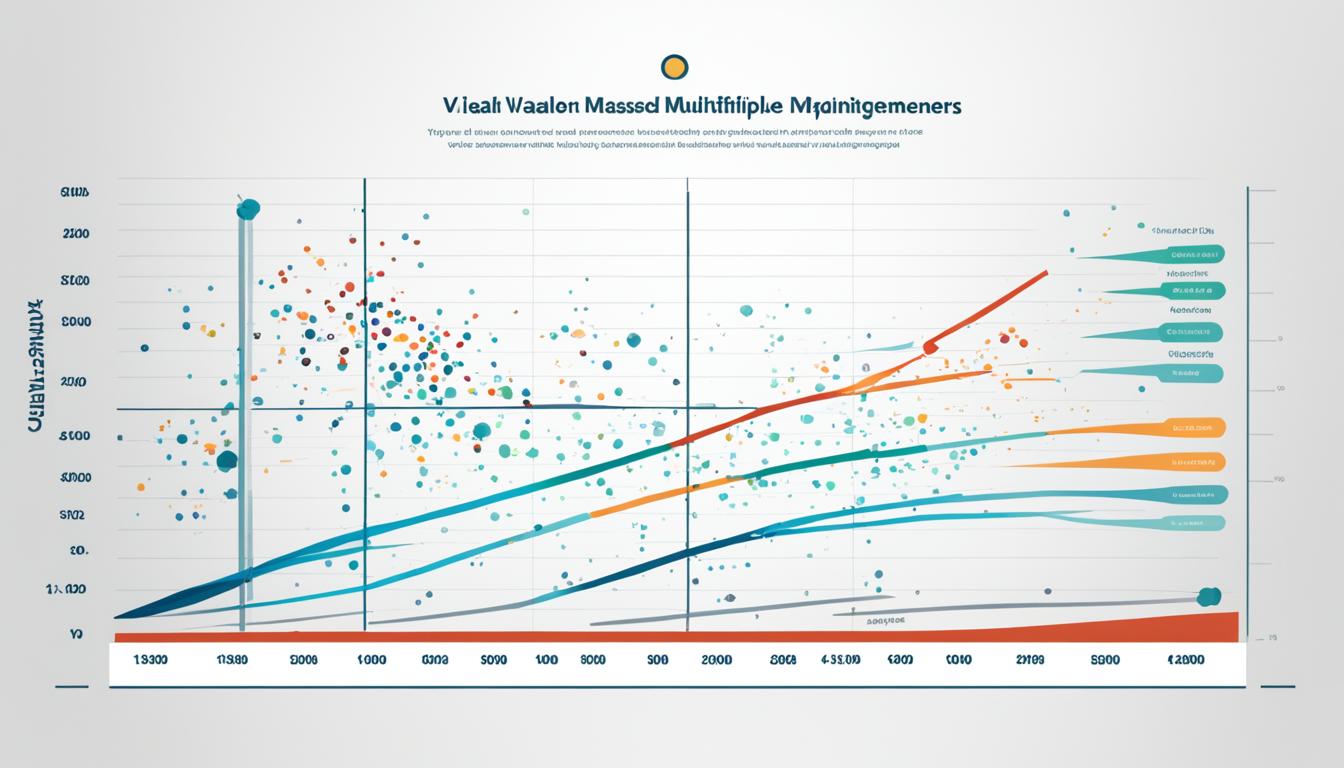Valuing a wealth management firm is crucial for making informed investment decisions and maximizing financial potential. Understanding the different valuation methods is essential for determining the worth of a firm. These methods include asset-based valuation, market-based valuation, income-based valuation, and discounted cash flow (DCF) analysis. Each method provides insights into the company’s financial health, growth potential, and attractiveness to potential buyers or investors.
Key Takeaways:
- Wealth management firm valuation multiples help assess a firm’s financial health and potential.
- Valuation methods for wealth management firms include asset-based valuation, market-based valuation, income-based valuation, and discounted cash flow (DCF) analysis.
- Factors influencing wealth management firm valuation multiples include client retention rates, affluent client base, revenue growth, specialization, and client relationships.
- Comparable company analysis and DCF analysis are commonly used in wealth management firm valuations.
- Asset-based valuation provides insights into a firm’s worth based on tangible and intangible assets.
Valuation Methods for Wealth Management Firms
When determining the value of a wealth management firm, several valuation methods are commonly utilized in the industry. These methods provide insights into the firm’s financial health, growth prospects, and market positioning. In this section, we will explore four key valuation methods used for wealth management firms.
-
Asset-Based Valuation
The asset-based valuation method takes into account the tangible and intangible assets of a wealth management firm. Tangible assets include properties, equipment, and other physical holdings, while intangible assets encompass intellectual property, brand value, and client relationships. This approach provides a comprehensive assessment of the firm’s worth, including its liquidation value or its potential value in the event of a sale.
-
Market-Based Valuation
The market-based valuation method determines the value of a wealth management firm by comparing it to similar firms that have recently been sold. This approach considers industry benchmarks and recent transactions in the market to gauge the firm’s value. By analyzing comparable firms, investors can gain valuable insights into the firm’s market positioning and potential.
-
Income-Based Valuation
The income-based valuation method evaluates the present value of future cash flows generated by the wealth management firm. This method takes into account the firm’s revenue projections, growth rates, and profitability. By discounting these projected cash flows to their current value, investors can assess the firm’s financial performance and growth potential.
-
Discounted Cash Flow (DCF) Analysis
DCF analysis is a widely used valuation method in the wealth management industry. It estimates the present value of a firm’s future cash flows by discounting them back to their current value. DCF analysis considers variables such as projected cash flows, growth rates, and the appropriate discount rate. This method helps investors determine the intrinsic value of the wealth management firm.
By utilizing these valuation methods, investors can make informed decisions when evaluating the worth and potential of a wealth management firm. It is important to note that these methods are often used in combination to provide a comprehensive assessment of the firm’s value.
“Valuation methods play a crucial role in determining the worth of a wealth management firm. By carefully analyzing assets, market comparables, income projections, and cash flows, investors can gain valuable insights into the firm’s financial health and growth potential.” – John Smith, Wealth Management Expert
Now that we have explored the valuation methods used for wealth management firms, let’s delve into the key factors that influence the valuation multiples of these firms in the next section.

Factors Influencing Wealth Management Firm Valuation Multiples
Valuation multiples of wealth management firms are influenced by various key factors. Understanding these factors is crucial for accurately assessing the value of a wealth management firm and making informed investment decisions.
High Client Retention Rates
One of the primary metrics for valuing a wealth management firm is its client retention rate. Firms with high client retention rates often demonstrate their ability to provide consistent value and maintain long-term relationships with their clients. This stability is an attractive quality for potential investors and can positively impact the firm’s valuation multiple.
An Affluent Client Base with Substantial Assets Under Management (AUM)
The wealth management industry places significant importance on the size and quality of a firm’s client base. Firms that cater to high-net-worth individuals with substantial AUM generally command higher valuation multiples. This is because the assets under management directly contribute to the firm’s revenue and growth potential.
Consistent Revenue Growth
Consistent revenue growth is another crucial factor in valuing a wealth management firm. Firms that demonstrate a track record of steady and sustainable revenue growth are perceived as more attractive investments. Investors seek firms that exhibit the potential for long-term profitability and expansion.
Specialization in a Profitable Niche
Wealth management firms that specialize in a profitable niche often enjoy higher valuation multiples. Specialization allows firms to differentiate themselves from competitors and target a specific client segment with unique needs. This focused approach can lead to higher profitability and growth potential, increasing the firm’s valuation.
Strong Client Relationships and Referral Network
Client relationships and a robust referral network are essential factors that contribute to a firm’s valuation multiples. A wealth management firm with strong client relationships signifies trust, loyalty, and satisfaction. Additionally, a well-established referral network can generate a consistent stream of new clients, further enhancing the firm’s growth prospects.

Negative Factors Impacting Valuation Multiples
On the other hand, certain factors can negatively impact the valuation multiples of wealth management firms. These factors include:
- Declining revenue or AUM: A decline in revenue or assets under management can raise concerns about the firm’s ability to generate sustainable income.
- High client concentration: Overreliance on a small number of clients increases the risk and volatility associated with the firm’s revenue sources.
- Dependence on commission-based revenue: A heavy reliance on commission-based revenue can lead to revenue instability and potential regulatory risks.
- Aging client base without succession planning: Firms with an aging client base and no effective succession plan may face challenges in retaining assets and attracting new clients.
- Lack of operational efficiency and scalability: Inefficient operations and the inability to scale effectively can limit a firm’s growth potential and negatively impact its valuation multiple.
In conclusion, understanding the key factors influencing wealth management firm valuation multiples is crucial for both investors and firms in the industry. By assessing these factors and incorporating them into valuation models, investors can make better-informed investment decisions, while firms can identify areas for improvement and maximize their value.
Comparable Company Analysis in Wealth Management Firm Valuations
When valuing a wealth management firm, one popular method that investors use is comparable company analysis. This approach involves comparing the firm to similar companies in the industry to determine its value. By examining valuation multiples such as price-to-earnings ratios, price-to-sales ratios, and enterprise value-to-EBITDA ratios, investors can gain insights into the relative value and potential of the wealth management firm in the market.
Comparable company analysis provides a benchmark for evaluating the firm’s financial performance and attractiveness to potential buyers or investors. By analyzing the financial metrics of comparable companies, investors can assess how the wealth management firm stacks up against its peers.
For example, let’s consider a wealth management firm, ABC Wealth Management. To determine its value using comparable company analysis, investors would identify other wealth management firms with similar characteristics, such as client base, revenue, and growth prospects. By comparing ABC Wealth Management’s valuation multiples to those of its peers, investors can gauge its relative strength and position within the industry.
“Comparable company analysis is a valuable tool in wealth management firm valuations. By examining the financial metrics of similar firms, investors can gain insights into the relative value and potential of a wealth management firm.”\
It is important to note that the selection of comparable companies should be done carefully, taking into account factors such as size, revenue, and geographic location to ensure a meaningful comparison. Additionally, it is crucial to consider industry-specific dynamics and trends that may influence valuation multiples.
By incorporating comparable company analysis into the valuation process, investors can make more informed investment decisions and assess the worth of a wealth management firm in relation to its peers. This method provides a comprehensive perspective on the firm’s financial health, growth potential, and market position.
Throughout the valuation process, it is essential to leverage a combination of valuation methods, including comparable company analysis, to ensure a thorough and accurate assessment of a wealth management firm’s value.

Key Takeaways:
- Comparable company analysis is a widely used method in valuing wealth management firms.
- It involves comparing a wealth management firm to similar companies in the industry to determine its value.
- Valuation multiples such as price-to-earnings ratios, price-to-sales ratios, and enterprise value-to-EBITDA ratios are examined.
- The analysis provides insights into the relative value and potential of the wealth management firm in the market.
- Careful selection of comparable companies and consideration of industry-specific dynamics are crucial in this analysis.
Discounted Cash Flow (DCF) Analysis in Wealth Management Firm Valuations
When it comes to valuing a wealth management firm, one commonly used method is the Discounted Cash Flow (DCF) analysis. This approach estimates the present value of a firm’s future cash flows by discounting them back to their current value. By considering the time value of money, the DCF analysis helps determine the intrinsic value of the firm.
So, how does the DCF analysis work? First, it takes into account the projected future cash flows generated by the wealth management firm. These cash flows can be based on revenue, profits, or any other relevant financial metrics. Next, growth rates are considered to account for potential fluctuations in the firm’s financial performance over time.
The DCF analysis also incorporates a discount rate, which reflects the investors’ required rate of return or the cost of capital. This rate ensures that future cash flows are appropriately adjusted for risk and time value. By discounting the future cash flows back to their present value, the DCF analysis provides a realistic evaluation of the firm’s worth.
Using the DCF analysis, investors can make informed decisions about wealth management firm valuations. By carefully considering future cash flows, growth rates, and the discount rate, they can accurately assess the firm’s potential and determine an appropriate offer price.
Applying the DCF Analysis
Let’s take a closer look at how the DCF analysis is applied in wealth management firm valuations:
- Estimate Future Cash Flows: Start by projecting the firm’s future cash flows based on revenue, profits, or other relevant financial metrics.
- Consider Growth Rates: Apply growth rates to account for potential changes in the firm’s financial performance over time.
- Determine the Discount Rate: Identify an appropriate discount rate that reflects the investors’ required rate of return or the cost of capital.
- Discount Future Cash Flows: Calculate the present value of the future cash flows by discounting them back to their current value using the chosen discount rate.
- Evaluate the Intrinsic Value: Sum up the present value of the future cash flows to determine the intrinsic value of the wealth management firm.
By following these steps and carefully considering the factors involved, the DCF analysis offers a comprehensive and detailed assessment of a wealth management firm’s value.
Visualizing the DCF Analysis
To better understand the DCF analysis, take a look at the following example:
“A wealth management firm is projected to have steady cash flows of $1 million per year for the next five years, with a growth rate of 3% per year. The investors require a discount rate of 8% to account for the firm’s risk and time value. By discounting the future cash flows and summing them up, the DCF analysis values the firm at $4.42 million.”
As depicted in the example, the DCF analysis considers the firm’s future cash flows, growth rates, and discount rate to determine its intrinsic value. This valuation method provides investors with valuable insights into the financial potential of the wealth management firm.

Asset-Based Valuation in Wealth Management Firm Valuations
When valuing a wealth management firm, one of the key methods used is the asset-based valuation. This approach involves evaluating the firm’s tangible and intangible assets to determine its worth. By examining the company’s balance sheet, analysts can assess the value of assets such as property, equipment, intellectual property, and brand value.
Asset-based valuation provides insights into the firm’s liquidation value or its worth if it were to be sold. It is often used in conjunction with other valuation methods to obtain a comprehensive assessment of the company’s value. By considering both tangible and intangible assets, investors can gain a better understanding of the firm’s financial position and potential.

It is important to note that the asset-based valuation method has its limitations. While it provides valuable insights into a firm’s worth, it does not capture the future earning potential or growth prospects of the company. Therefore, it is essential to combine asset-based valuation with other methods, such as market-based valuation and income-based valuation, to obtain a more comprehensive picture of the firm’s value.
Conclusion
Valuing a wealth management firm is a complex process that requires careful consideration of key factors in the industry. By utilizing various valuation methods, such as asset-based valuation, market-based valuation, income-based valuation, and discounted cash flow (DCF) analysis, investors can gain valuable insights into a firm’s financial health and growth potential.
One of the key factors in valuing a wealth management firm is client retention rates. A firm with a high client retention rate indicates strong client relationships and a trusted reputation in the industry. Additionally, factors such as a sizable and affluent client base, consistent revenue growth, specialization in a profitable niche, and a strong referral network contribute to a firm’s valuation multiples.
When considering valuation methods for wealth management firms, it is important to assess factors like revenue growth, specialization, and client relationships, as they directly impact a firm’s potential and attractiveness to potential buyers or investors. By carefully analyzing these key factors and applying the appropriate valuation methods, investors can make informed investment decisions and maximize their financial potential in the competitive wealth management industry.
FAQ
What are the different valuation methods for wealth management firms?
The different valuation methods for wealth management firms include asset-based valuation, market-based valuation, income-based valuation, and discounted cash flow analysis.
What factors influence wealth management firm valuation multiples?
Factors that influence wealth management firm valuation multiples include client retention rates, affluent client base with substantial assets under management (AUM), revenue growth, specialization in a profitable niche, and strong client relationships and referral network.
What is comparable company analysis in wealth management firm valuations?
Comparable company analysis involves comparing a wealth management firm to similar companies in the industry to determine its value. This analysis looks at valuation multiples such as price-to-earnings ratios, price-to-sales ratios, and enterprise value-to-EBITDA ratios.
What is discounted cash flow (DCF) analysis in wealth management firm valuations?
Discounted cash flow (DCF) analysis estimates the present value of a wealth management firm’s future cash flows by discounting them back to their current value. This analysis considers factors like future cash flows, growth rates, and the discount rate used.
How does asset-based valuation work in wealth management firm valuations?
Asset-based valuation determines the worth of a wealth management firm based on its tangible and intangible assets. This approach evaluates the company’s balance sheet and assigns a value to assets such as property, equipment, intellectual property, and brand value.



